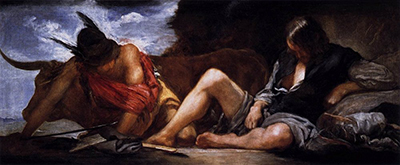Mercury and Argus was one of Velazquez's last few paintings, arriving as it did just a year before the artist's death. It's qualities show us someone at the height of their talents, and it is now a significant part of the collection of the Prado Museum in Madrid, Spain.
Here we find Mercury on the left hand side, lying down in a darkly lit setting. His winged hat is entirely how artists would tend to identify him within art, and he also holds a flute too. The music that he plays has forced the shepherd on the right to fall asleep, leaving all those that he protected to be entirely vulnerable. The story goes that Jupiter had sent Mercury in order to trick the shepherd, Argos, so that Io the cow could be captured. She was actually a beautiful nymph being disguised as a cow in order to keep her away from the very same man who came up with this plan. The tale appears in Ovid's Metamorphoses and offers plenty of moral and symbolic meanings that understandably have attracted a number of artists over the years.
The lighting found here adds to the drama as the daring and calculated Mercury makes his move. Perhaps the darkness also represents the evil mind of this figure as he follows the order given to him. He lurks in the shadows, like a wolf readying to attract a farmer's flock. Ovid's Metamorphoses features a number of other passages that have also become common themes within European art and it has become a major element in the teachings of literature and remains that today. Head to the Prado Museum in Spain in order to view this artwork, though one needs to know this back story in order to truly understand just what they are looking at. Also learn more about Velazquez in this biography.
This was not the only artist to make use of Mercury and Argus as inspiration for their work. In fact, they appear many times across European art history, most frequently during the Renaissance and Baroque eras. Perhaps the two most memorable versions besides this one would be by Jacob Jordaens and Peter Paul Rubens, who were two of the stars of Flemish art at around the same time as Velazquez was building connections within Spain, and later Italy. Rubens' version of Mercury and Argus came between 1635 and 1638 and offers a greener, brighter landscape in comparison to the work of Velazquez found in this page. They would all have learnt from each other, even though travel was much harder to organise all those years ago. Prints would sometimes be produced as a means to spreading an artist's reputation and there was also enough discussion within the community that people became aware of the great artists and movements that were taking place elsewhere in Europe.




